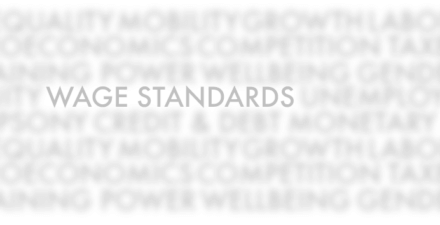New research highlights the necessity of improving wage standards and bargaining power for low-wage workers in the United States

A new working paper sheds new light on the lack of bargaining power among low-wage workers in the United States by examining workers’ ability to bargain over wages when they are dual jobholders. The paper, “Wage Posting or Wage Bargaining? A Test Using Dual Jobholders,” examines whether improvements in the wages of workers’ second jobs increase their ability to bargain for higher wages in their primary jobs.
The new working paper, by economists Marta Lachowska at the W.E. Upjohn Institute for Employment Research, Alexandre Mas at Princeton University, Raffaele Saggio at the University of British Columbia, and Stephen Woodbury at Michigan State University, is an important contribution to economic research. It tests the extent to which two different models of wage determination—either wage posting or wage bargaining—come into play for workers at different wage levels.
The wage-posting model is a “take it or leave it” approach, where an employer posts a nonnegotiable wage at the point of making a job offer to a prospective employee. The wage-bargaining model, by contrast, proposes that wages are determined by a process of bargaining between workers and employers, which gives a worker the ability to seek a higher wage through the hiring process.
Using administrative linked employer-employee data on workers in Washington state, the researchers test which model is more prevalent by looking at how workers respond to wages at their second jobs, where they can use outside income to improve their bargaining position at their current employer or choose to leave their employer if they are not able to seek higher pay at their primary job. Their findings are telling when considered across the breadth of the U.S. labor market.
The four researchers find that the effects of wage bargaining are small overall and apply most to high-wage workers, who have a relatively greater ability to use their outside options to bargain for higher wages. But the wage-bargaining model does not appear to apply to low-wage workers. For them, the wage-posting model better explains their behavior in the job market because they generally can only raise their wages by quitting their primary job in exchange for a higher-paying job elsewhere.
Taken together, this means that bargaining over wages at a current job generally does not achieve a large impact on workers’ wages in general, but high-wage workers can more often bargain at their current jobs to improve their wages, while low-wage workers can do very little to improve their wages at their jobs other than leave for a new one.
Wage Posting or Wage Bargaining? A Test Using Dual Jobholders
November 16, 2021
These findings suggest that wages are posted at a given, nonnegotiable rate for low-wage jobs, leaving workers in these jobs with little ability to bargain over their wages. This helps explains why market-level solutions such as raising the minimum wage are so effective for low-wage jobs in the current legal landscape.
The new research also illuminates another possible way that the lack of bargaining power for low-income workers exacerbates income inequality, as other research suggests that wages tend to be higher when workers can bargain over them, compared to when the “take it or leave it” wage-posting model is employed at their workplaces.
These findings together can help economists and policymakers alike understand how wages are determined in the U.S. labor market and how this connects to wage inequality. A growing body of research shows that employers have outsized power in employment relationships in the United States, allowing them to undercut workers’ wages. As a result, workers are paid over one-third less than they would be in a truly competitive labor market.
This outsized employer power—which economists refer to as monopsony—reinforces pay discrimination by race, ethnicity, and gender. This imbalance also is connected to the decline in unions’ power and coverage over the past several decades. Unions are a key institution supporting workers’ bargaining power across the U.S. labor market, even in non-union-organized companies.
The importance of unions is not lost on U.S. workers. Equitable Growth grantee Alexander Hertel-Fernandez notes that there is strong worker demand for unions, but federal and state labor laws generally do not allow for approaches that could help large numbers of workers, such as industrywide or statewide collective bargaining.
Conclusion
These findings are important for policymakers who want to improve wages for low-income workers and reduce income inequality. The working paper shows that low-wage U.S. workers don’t have appreciable bargaining power under current U.S. labor market dynamics and laws and institutions.
What’s more, other economic evidence demonstrates that policymakers can address market-level factors underpinning persistent low-wages by instituting statutory minimum wages that would increase posted wages and by addressing the structural conditions that increase low-wage workers’ bargaining power, such as income support programs and support for institutions that foster wage bargaining such as labor unions.
Because low-wage workers in the United States have so little bargaining power, the steady erosion of the federal minimum wage has contributed to rising economic inequality and stagnant and declining wages for workers in the lower part of the pay distribution. This means raising wage standards is one of the most important and effective approaches to improving wages for low-wage workers.
Higher minimum wages also are critical for addressing racial wage gaps. A 2019 analysis by economist Valerie Wilson at the Economic Policy Institute found that increasing the federal minimum wage to $15 an hour would increase earnings for 38.1 percent of Black workers and 23.2 percent of White workers.
There also is a range of policy options to increase worker power, requiring policy changes across many fronts. For instance, research shows that strong unions can counteract employers’ wage-setting power, which is why recent proposed legislation, such as the PRO Act, focuses on addressing the structural policy barriers that keep workers from joining unions. In addition, “just cause” job protections can support worker power by protecting workers from retaliation for organizing. And strategic and co-enforcement of labor standards can help protect vulnerable U.S. workers from wage theft and other labor standards violations.





